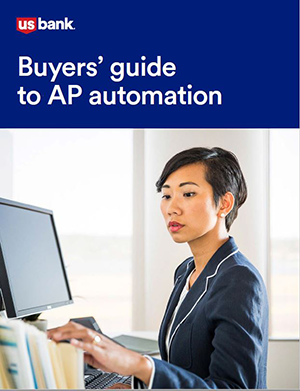
How to keep your assets safe

Essential tips for preventing check fraud


Ever since computers started making calculations quicker and communications easier, businesses have been leveraging their power to become more efficient. At first, workers simply used the computers for more efficiency, but over time, automation of some processes created an opportunity to increase efficiency even more.
When manual, tedious tasks can be isolated and automated, the cost savings are obvious. However, the truly exciting stage in an automation journey is when you are not only saving money through efficiency but can also identify additional savings through analytics and optimizations. That’s the extra step that allows optimized businesses to uncover additional opportunities by automating accounts payable (AP).
The entire procure-to-pay lifecycle is ripe for automation because, as anybody who has spent time matching invoices with purchase orders can tell you, there has traditionally been an awful lot of simple, time-consuming, easily replicated work involved in the process.
Yet AP automation can create optimization opportunities that go well beyond creating efficiency by:
Sound too good to be true? It all starts with digitization and automation, which create efficiency and lead to additional savings through optimization.
"If you're a business and you're proactive, you will be looking to drive efficiency in your AP operation, trying to minimize the amount of manual work your teams do every day as it relates to the invoice-to-pay or accounts payable process,” says Anuradha Somani, Head of Payments, Global Treasury Management at U.S. Bank. “You can start with the invoicing process, taking the manual work out of that process, automate matching to the purchase order and moving faster to approval to pay.”
Eliminating paper payments is at the heart of most banking automation. Digitization allows seamless, automated data processing between an accounting system or ERP (enterprise resource planning) system and your bank or payment service provider. But automation requires more than simple digitization. Although an emailed invoice is “digital,” it’s not integrated. For these purposes, an emailed invoice isn’t much different than paper – each still needs to be captured in your system of record, whether that’s an ERP or homegrown accounting system, to facilitate automation.
Once it is captured, the data is matched to a purchase order, and the invoice is approved to pay.
“If that process is manual, invoice management is the most time-consuming part of the payables process,” she says. “There’s so much opportunity to drive efficiency by automating that process. Instead of spending all that time doing something that can be fully automated, you could spend your time managing the exceptions, working on supplier engagement or other activities altogether.”
“Additional savings and optimizations are available to businesses who choose to automate. When an AP department centralizes its process, reconciliation and analytics benefits also become available.”
Once the invoices are matched and approved, payments can be automated by digitizing them. Rather than spending time and money to print checks, digital payments are delivered automatically, and in some cases, instantaneously, creating layers of efficiency – and opportunity.
“If I'm sending predominantly checks today, they're taking two or three days for the U.S. mail to deliver them – or even more,” Somani notes. “I have to deal with sending them earlier if I’m sending paper, and there’s the cost of printing, the cost of postage. Those costs and inefficiencies disappear with digital payments.”
And the faster a business can approve invoices, the faster it’s prepared to make an early payment. That flexibility to make an early payment is not only a benefit to the payer but also to the supplier.
“It’s all working capital related,” she explains. “You may be able to discuss with your suppliers the opportunity to take a discount on an invoice payment the earlier you pay in the cycle. That really can contribute to the better working capital and liquidity for your suppliers. And it enables you to save money as the payer, so it's potentially a win-win.."
Next level savings – adding revenue through rebates and the network effect
Automating AP with digital payments not only reduces cost but can also generate rebates to offset banking fees.
“In some cases, suppliers will agree to accept an electronic payment,” Somani says. “In return for receiving remittance data electronically, getting paid a little faster, reducing the cost on their end to process paper checks, they may agree to a fee in the form of interchange on a virtual card payment or a premium price to receive ACH payments, sometimes called Premium ACH, instead of checks. They may accept this fee because digital payments can improve the strength of the buyer-supplier relationship by enabling a better experience on both sides of the transaction.” The fee accepted by the supplier turns into a rebate for the payer.
When a business can tap into a large existing network of suppliers that are global acceptors of virtual card, premium ACH and basic ACH, it may not only absorb banking fees associated with the payables operation, but may also create a net profit situation for the AP department where the aggregate amount of the rebates can exceed banking fees.
Best-in-class solutions are able to automate nearly 100 percent of your process and convert anywhere from 50 to 80 percent of paper payments to electronic payments.
Additional opportunities – reconciliation, analytics and fraud risk mitigation
Additional savings and optimizations are available to businesses who choose to automate. When an AP department centralizes its process, reconciliation and analytics benefits also become available.
“An overlooked component of the AP process is the concept of the payment roundtrip. The process doesn’t really end until that open payable is closed out in the payer’s ERP system,” Somani explains. “The gold standard for payment reconciliation is having the transaction ID flow with the payment right into the previous day information reporting, and when loaded into the ERP, it can be automatically matched to the open payable. In many cases that transaction ID is not present in bank reporting, causing manual effort to reconcile accounts. By working with a provider that can help you automate the reconciliation process, it can be a significant timesaver.”
Beyond saving time, that level of automation can save even more money. Best-in-class automation provides the analytics to:
By the same token, a best-in-class AP automation system can also reduce the risk of payment fraud. Account verification and validation is the new industry standard for fraud risk mitigation. Every time the business adds a new supplier and every time a supplier wants to change their account number, best-in-class solutions will verify that the supplier name matches the name that's associated with the account number.
That’s crucial in the case of a common payment scam known as business email compromise (BEC), where a business is tricked into sending payment to an account number they think belongs to a legitimate payee, but actually belongs to a criminal. How common? According to the 2020 AFP Payments Fraud and Control Survey Report, 81 percent of companies experienced attempted or actual payments fraud attacks.
“You prevent against that by validating that the name of the payee is tied to the account number,” Somani explains. “Best-in-class AP automation solutions basically eliminate that risk because you’re dealing with a closed system. The data is being stored in a place where if there's ever a request for a change to the account, it can be pre-validated before a payment goes out the door.”
Because industry standard AP automation providers store supplier bank accounts and other sensitive information within a secure system, they also protect against data theft, which has a value that goes beyond the bottom line.
“Imagine the impact to the relationship with my suppliers if their bank accounts were stolen and every single one of my suppliers had to change their bank account,” Somani says. “That’s something businesses are always worried about, and it all but disappears with robust fraud protection capabilities.”
Optimize and secure your invoice-to-pay process by contacting your treasury management consultant. Learn how U.S. Bank is helping automate accounts payable.


